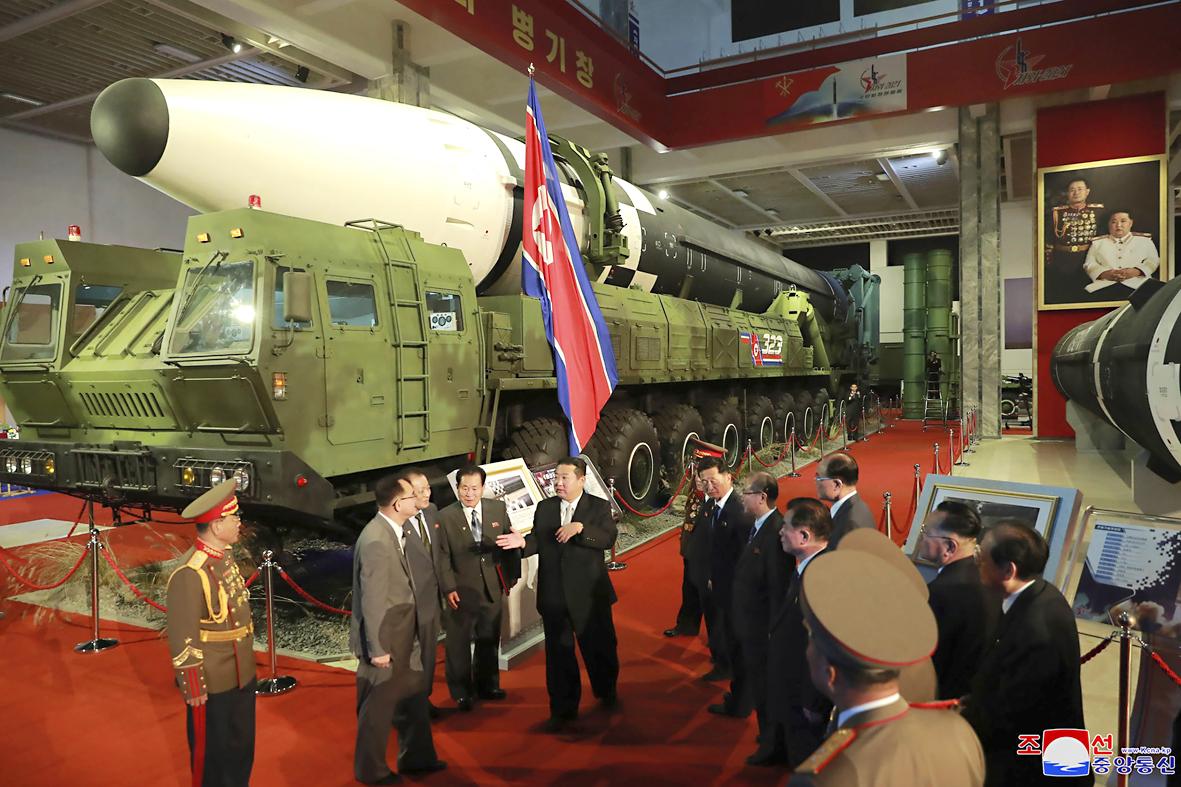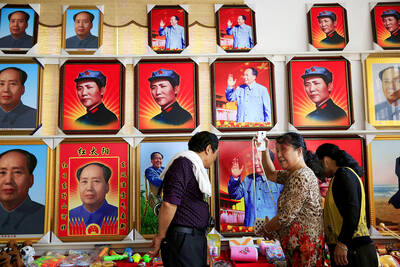North Korea’s recent test-missile explosion is unlikely to stop leader Kim Jong-un from chasing big plans this year to boost a nuclear arsenal he hopes will challenge his archrival, the US.
Kim, in fact, may use it as a stepping stone to his first intercontinental ballistic missile test launch in years — and of the North’s biggest weapon — while diplomacy with Washington remains stalled.
It’s unclear what went wrong with Wednesday’s launch or how soon North Korea will conduct another test.

Photo: AFP
What many observers agree on is the North’s next goal: A space launch for a spy satellite that simultaneously tests technology for an ICBM that could accurately target all of the continental US, possibly with multiple nuclear warheads.
Success would allow Kim to add major new weapons systems to his arsenal, boost public support at home and increase his leverage in future negotiations with a Biden administration that is increasingly distracted with the war in Ukraine and other major issues.
Here’s look at what North Korea might be up to during one of its busiest weapons testing runs in years.
A MONSTER ICBM
Days before North Korea’s failed launch Wednesday, Pyongyang conducted two mid-range ballistic missile firings that it said were designed to test cameras for a reconnaissance satellite. US and South Korean officials, however, said the launches were meant to test a new ICBM system first displayed during a North Korean military parade in 2020.
That weapon is the developmental 25-meter Hwasong-17 missile, the North’s longest-range weapon and, by some estimates, the world’s biggest road mobile ballistic missile system. Its potential maximum range of 15,000 kilometers places all of the continental US within striking distance.
North Korea has other ICBMs, and its flight-tests in 2017 demonstrated an ability to reach the American homeland. But experts say that the Hwasong-17’s size suggests it can carry a bigger payload or multiple nuclear warheads that can defeat missile defense systems.
“Putting three warheads on it would allow them to drop one bomb on Washington, DC, a second one on New York and a third one on Chicago,” said Chang Young-keun, a missile expert at the Korea Aerospace University in South Korea.
In ballistic missile launches on Feb. 27 and March 5, experts say North Korea likely tested the first-stage rocket for the Hwasong-17. South Korean military officials suggested that Wednesday’s launch also involved parts of the Hwasong-17.
A SPY SATELLITE
Kim last year publicly vowed to acquire a spy satellite, along with a missile that can carry multiple warheads and the ability to precision attack targets 15,000 kilometers away.
North Korea has already put two Earth observation satellites in orbit. But the launches were primarily meant to improve its long-range missile technology, and there is no evidence that the satellites have ever relayed spaced-based imagery back to the North.
“North Korean missiles’ efficiency will be low without a reconnaissance satellite,” Chang said. “They can (precisely) strike targets only when they have accurate information about them.”
Before a spy satellite launch, Pyongyang will likely inform international aviation and maritime authorities of a launch window, something it did in its previous satellite liftoffs, said Lee Choon-geun, an honorary research fellow at South Korea’s Science and Technology Policy Institute.
The United States and its allies are certain to condemn such a launch as a cover for a missile test. But they’ll likely fail to get new UN sanctions against North Korea because China and Russia, two of veto-wielding members of the UN Security Council and friends of the North, will object.
Chang said North Korea hasn’t likely acquired a high-level spy satellite because of UN sanctions that ban the import of necessary materials, but it can still use existing technology and carry out a launch if it opts for a more political message toward the US.
A launch might happen before the April 15 birth anniversary of Kim’s late grandfather and state founder Kim Il-sung, or the May 10 inauguration of a new conservative South Korean president.
WHAT KIM WANTS
Wednesday’s launch was the North’s 10th weapons test this year. The high number demonstrates Kim’s determination to cement the North’s status as a nuclear power and to wrest concessions from Washington from a position of strength, said Park Won-gon, a professor of North Korea studies at Seoul’s Ewha Womans University.
“North Korea is focusing everything on that goal because their possibility of achieving it has never been higher,” Park said.
Washington’s preoccupation with the Russia-Ukraine war and its intensifying competition with Beijing could allow the North to think it could get away with more provocative weapons demonstrations, such as a resumption of long-range missile testing.
The Russian invasion of Ukraine doesn’t likely offer direct lessons for Pyongyang about the risks of denuclearizing. That’s because Ukraine never had operational control over the nuclear weapons it transferred to Russia following the collapse of the Soviet Union. But Son Hyo-jong, a researcher for Seoul’s Korea Institute for Defense Analyses, recently wrote that North Korea may understand that Russia never would have attacked Ukraine if it didn’t have nuclear weapons and ICBMs to prevent the US from interfering. That could give Kim added reason to pursue nuclear arsenal as a way to stand up to the US.
North Korea’s recent testing activity is part of Kim’s efforts to advance and modernize his country’s nuclear and missile arsenal to cope with what he calls US hostility.
Since taking power in late 2011, Kim has carried out more than 70 rounds of ballistic missile tests, compared with 22 rounds during his father Kim Jong-il’s 17-year rule and nine rounds during Kim Il-sung’s 46-year rule.
“Kim Jong-un has been saying he’s made his country into a military power ... and that’s something that his father and grandfather didn’t achieve,” said analyst Seo Yu-seok at the Seoul-based Institute of North Korean Studies. “Now it appears impossible to revive his economy, so he may think it’s better to further boost his military credentials.”

Taiwan can often feel woefully behind on global trends, from fashion to food, and influences can sometimes feel like the last on the metaphorical bandwagon. In the West, suddenly every burger is being smashed and honey has become “hot” and we’re all drinking orange wine. But it took a good while for a smash burger in Taipei to come across my radar. For the uninitiated, a smash burger is, well, a normal burger patty but smashed flat. Originally, I didn’t understand. Surely the best part of a burger is the thick patty with all the juiciness of the beef, the

The ultimate goal of the Chinese Communist Party (CCP) is the total and overwhelming domination of everything within the sphere of what it considers China and deems as theirs. All decision-making by the CCP must be understood through that lens. Any decision made is to entrench — or ideally expand that power. They are fiercely hostile to anything that weakens or compromises their control of “China.” By design, they will stop at nothing to ensure that there is no distinction between the CCP and the Chinese nation, people, culture, civilization, religion, economy, property, military or government — they are all subsidiary

Nov.10 to Nov.16 As he moved a large stone that had fallen from a truck near his field, 65-year-old Lin Yuan (林淵) felt a sudden urge. He fetched his tools and began to carve. The recently retired farmer had been feeling restless after a lifetime of hard labor in Yuchi Township (魚池), Nantou County. His first piece, Stone Fairy Maiden (石仙姑), completed in 1977, was reportedly a representation of his late wife. This version of how Lin began his late-life art career is recorded in Nantou County historian Teng Hsiang-yang’s (鄧相揚) 2009 biography of him. His expressive work eventually caught the attention

This year’s Miss Universe in Thailand has been marred by ugly drama, with allegations of an insult to a beauty queen’s intellect, a walkout by pageant contestants and a tearful tantrum by the host. More than 120 women from across the world have gathered in Thailand, vying to be crowned Miss Universe in a contest considered one of the “big four” of global beauty pageants. But the runup has been dominated by the off-stage antics of the coiffed contestants and their Thai hosts, escalating into a feminist firestorm drawing the attention of Mexico’s president. On Tuesday, Mexican delegate Fatima Bosch staged a